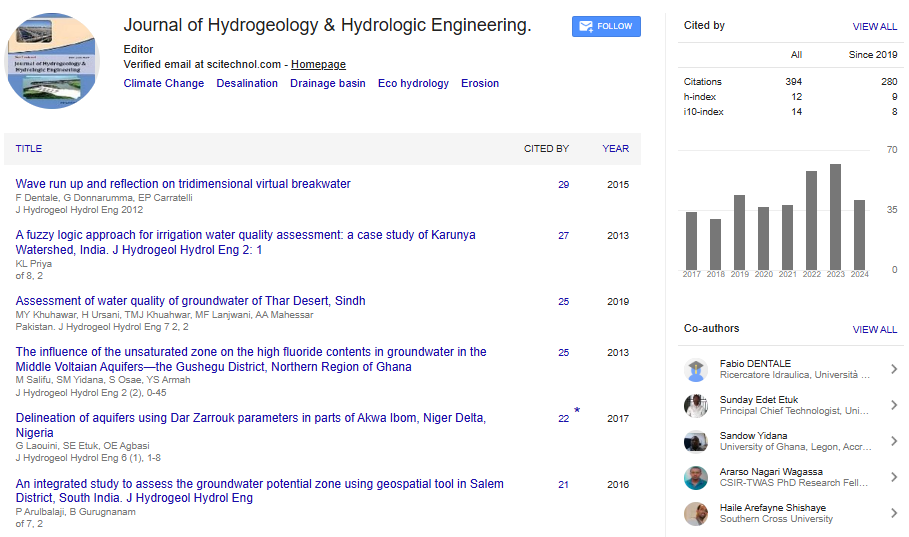Short Communication, J Hydrogeol Hydrol Eng Vol: 13 Issue: 4
Effective Strategies for Sustainable Water Management
Seong Kang*
1Department of Environmental Science, University of Florence, Florence, Italy
*Corresponding Author: Seong Kang,
Department of Environmental Science,
University of Florence, Florence, Italy
E-mail: kangs456@gmail.com
Received date: 29 July, 2024, Manuscript No. JHHE-24-149252;
Editor assigned date: 31 July, 2024, PreQC No. JHHE-24-149252 (PQ);
Reviewed date: 14 August, 2024, QC No. JHHE-24-149252;
Revised date: 21 August, 2024, Manuscript No. JHHE-24-149252 (R);
Published date: 29 August, 2024, DOI: 10.4172/2325-9647.1000340
Citation: Kang S (2024) Effective Strategies for Sustainable Water Management. J Hydrogeol Hydrol Eng 13:4.
Description
Water management plays a significant role in ensuring the availability of clean and safe water for both current and future generations. As global populations grow, demand for water increases, while climate change and pollution further threaten water resources. To address these challenges, adopting sustainable water management strategies is essential.
One of the pressing challenges in water management is water scarcity, particularly in arid and semi-arid regions. This issue is exacerbated by population growth, urbanization and industrial activities, which place higher demands on available water resources. Droughts, irregular rainfall patterns and the over-extraction of groundwater have led to depletion of aquifers, rivers and lakes, resulting in long-term damage to ecosystems [1].
In addition to water scarcity, pollution is another significant issue. Industrial discharges, agricultural runoff and untreated sewage contaminate water bodies, making it unsafe for human consumption and damaging aquatic ecosystems. Effective management systems need to address these concerns to maintain water quality [2].
Integrated Water Resources Management (IWRM) is a comprehensive approach that promotes the coordinated management of water, land and related resources. It involves collaboration among stakeholders, including governments, local communities and industries, to make informed decisions that benefit both people and the environment [3]. By balancing ecological, social and economic needs, IWRM fosters long-term sustainability.
Water conservation is vital in reducing pressure on freshwater resources. Simple methods such as reducing water consumption, fixing leaks and installing water-efficient appliances can significantly decrease domestic water use [4]. In agriculture, drip irrigation systems and rainwater harvesting can help conserve water while maintaining crop productivity. Industries can also implement water recycling processes to reduce their dependence on freshwater.
Proper wastewater treatment is essential in preventing contamination of water bodies. Municipalities and industries should invest in modern treatment technologies that remove harmful substances before water is released back into rivers and lakes [5]. Governments can impose regulations and enforce penalties to deter illegal dumping of waste into water sources.
Advances in technology have provided new solutions for better water management. Remote sensing and Geographic Information Systems (GIS) allow for monitoring water bodies and identifying areas at risk of pollution or depletion [6]. Smart sensors can help detect leaks in water distribution systems, while advanced modeling techniques predict water availability under different climate scenarios. Desalination, which turns seawater into freshwater, is another innovative method used in water-scarce regions.
Engaging local communities in water management decisions is an effective way to ensure success. Communities are directly affected by water policies and are often the first to experience the consequences of poor management [7]. Their input can guide more practical and tailored solutions. Educational programs can also raise awareness of sustainable practices, promotion a culture of water.
Water management must evolve to address the impacts of climate change. Rising temperatures, shifting rainfall patterns and the increased frequency of extreme weather events such as floods and droughts have a direct effect on water availability. Adaptation measures may include building infrastructure such as reservoirs, dams and flood defenses to manage water supplies during dry periods and protect against flooding.
Addressing water challenges requires a multifaceted approach involving policy reform, technological innovation and public engagement. Governments play a vital role in developing regulatory frameworks and allocating resources, while the private sector can contribute by adopting sustainable practices [8-10]. Moreover, international collaboration is necessary for transboundary water bodies, ensuring equitable distribution and sustainable use across borders.
Conclusion
Sustainable water management is achievable through the combination of strategic policies, conservation efforts, technological innovation and community involvement. By implementing these practices, societies can ensure the long-term availability and quality of water, benefiting both people and the planet.
References
- Ashley R, Gersonius B, Digman C, Horton B, Smith B, et al. (2018) Including uncertainty in valuing blue and green infrastructure for stormwater management. Ecosyst Serv 33: 237-246.
- Bell S (2015) Renegotiating urban water. Prog Plan 96: 1-28.
- Blecken GT, Hunt WF, Al-Rubaei AM, Viklander M, Lord WG (2017) Stormwater Control Measure (SCM) maintenance considerations to ensure designed functionality. Urban Water J 14(3): 278-290.
- Brown R, Farrelly M (2009) Delivering sustainable urban water management: A review of the hurdles we face. Water Sci Technol 59(5): 839-846.
[Crossref] [GoogleScholar] [Pubmed]
- Cettner A, Ashley R, Viklander M, Nilsson K (2013) Stormwater management and urban planning: Lessons from 40 years of innovation. J Environ Plan Manag 56(6): 786-801.
- Cousins JJ, Hill D (2021) Green infrastructure, stormwater, and the financialization of municipal environmental governance. J Environ Policy Plan 23 (5): 581-598.
- Gleick PH, Palaniappan M (2010) Peak water: Conceptual and practical limits to freshwater withdrawal and use. Proc Natl Acad Sci USA 107(25): 11155-11162.
- Priscoli DJ (2004) What is public participation in water resources management and why is it important?. Water Int 29(2): 221-227.
- Cosgrove CE, Cosgrove WJ (2013) Foresight as a tool in water resource development. Development 56(4): 484-490.
- Williams M, Zalasiewicz J, Haywood A, Ellis M (2011) The Anthropocene: A new epoch of geological time. Philos Trans R Soc A 369: 835-1111.
 Spanish
Spanish  Chinese
Chinese  Russian
Russian  German
German  French
French  Japanese
Japanese  Portuguese
Portuguese  Hindi
Hindi 
